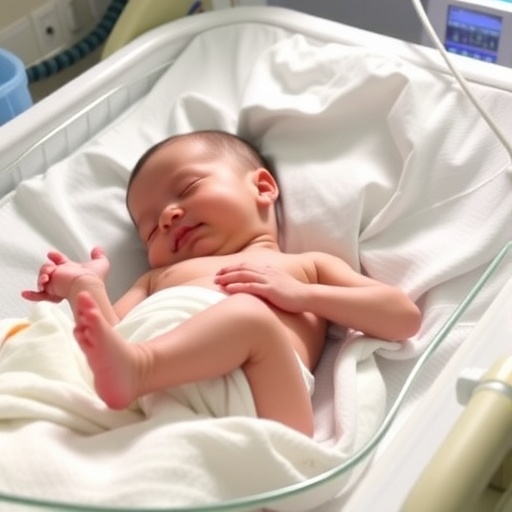In the relentless pursuit of optimizing care in neonatal intensive care units (NICUs), researchers have placed a spotlight on dexmedetomidine, a sedative that may redefine the standards of neonatal sedation. The latest study published on November 26, 2025, in the Journal of Perinatology investigates dexmedetomidine as a primary sedative agent for neonates, raising important questions about its safety and efficacy in this uniquely vulnerable population.
Dexmedetomidine, an alpha-2 adrenergic agonist, has been widely used in adult and pediatric patients for its sedative and analgesic properties. Unlike traditional sedatives that often carry risks of respiratory depression and prolonged sedation, dexmedetomidine offers the theoretical advantage of producing sedation without significant respiratory compromise. This characteristic is critical in neonates, who are particularly susceptible to respiratory instability, making sedation management a formidable clinical challenge.
The study led by Caballero et al. meticulously evaluates the outcomes associated with dexmedetomidine when used as the primary sedative in NICUs, an environment where sedation protocols must balance carefully between efficacy and neonatal safety. Traditionally, sedatives like benzodiazepines and opioids have dominated neonatal sedation strategies, but concerns over their adverse effects—including neuroapoptosis, prolonged sedation, and respiratory depression—have necessitated the search for safer alternatives.
In this pivotal investigation, neonates receiving dexmedetomidine were closely monitored for hemodynamic stability, respiratory function, sedation depth, and potential neurodevelopmental outcomes. The study’s design inherently acknowledges the fragility of the neonatal population, underscoring the importance of assessing not only immediate sedation efficacy but also the broader implications for growth and neural health.
One of the salient findings noted in the research is dexmedetomidine’s capacity to achieve adequate sedation without significant respiratory compromise. This is particularly transformative since it allows for ventilatory weaning or avoidance of mechanical ventilation altogether in some cases. The mechanism stems from dexmedetomidine’s selective activation of central alpha-2 receptors, leading to sedation that mimics natural sleep patterns, thereby preserving the integrity of respiratory drive.
Beyond its respiratory safety profile, dexmedetomidine also demonstrated favorable effects on cardiovascular parameters. While some hypotensive and bradycardic episodes were recorded, these were typically transient and manageable without long-term sequelae. The researchers emphasize that continuous hemodynamic monitoring remains essential, but overall, the drug’s impact on cardiovascular stability is considerably less adverse compared to other sedatives.
Critically, the neuroprotective effects attributed to dexmedetomidine in preclinical models kindle hope for its application in minimizing the cerebral risks associated with sedation. The study touches upon emerging evidence that dexmedetomidine may reduce neuroinflammation and oxidative stress, potentially safeguarding the developing brain against injury linked to prolonged sedation and critical illness.
Furthermore, researchers analyzed sedation depth using standardized neonatal sedation scales, ensuring that sedation was both sufficient and titratable. The flexibility in dosing allowed clinicians to fine-tune sedation levels, thereby minimizing oversedation, a common challenge with other agents that can lengthen NICU stays and negatively impact feeding and development.
The operational advantages extend beyond individual patient outcomes. Dexmedetomidine’s favorable pharmacokinetics, including a relatively short half-life allowing for rapid recovery, can enhance NICU workflow efficiency. This may translate into shorter durations of sedation, earlier extubation when applicable, and an overall reduction in NICU length of stay—metrics critical for healthcare resource optimization and parental bonding.
While the study heralds dexmedetomidine’s promise, the investigators stress the necessity for cautious interpretation, as the current data underscores the need for larger multicenter randomized trials. The nuanced differences in neonatal subpopulations—ranging from extremely low birth weight infants to those with complex congenital anomalies—require targeted investigation to delineate precise indications and contraindications.
Additionally, the research highlights challenges such as dosing variability and the lack of standardized sedation protocols incorporating dexmedetomidine across different NICUs. Standardization efforts and guideline development are pivotal next steps to ensure consistent application and maximized safety profiles.
From a pharmacological perspective, dexmedetomidine’s unique receptor activity offers potential adjunct benefits beyond sedation. For instance, its analgesic-sparing effects may reduce opioid dependence, limiting opioid-related adverse effects that are increasingly scrutinized in neonatal care.
The study also gestures toward the importance of parent-infant interaction during sedation. By enabling lighter, more manageable sedation states, dexmedetomidine might facilitate earlier and more frequent parental involvement, breastfeeding, and developmental care—all of which are fundamental to optimizing neonatal outcomes.
Emerging data on long-term neurodevelopmental follow-up in infants sedated with dexmedetomidine remain limited but encouraging. Early indicators suggest that dexmedetomidine may not impose adverse neurocognitive effects, yet fully understanding its safety profile requires longitudinal studies following infants well beyond NICU discharge.
In conclusion, the work by Caballero and colleagues marks an important stride forward in neonatal sedation research. Their findings illuminate dexmedetomidine’s potential as a safer, efficacious alternative to traditional sedatives, blending clinical effectiveness with a profile compatible to the delicate physiology of neonates. As the neonatal care community grapples with the complexities of sedation, this research may catalyze a paradigm shift, ultimately refining how we comfort and protect our most fragile patients.
Ongoing exploration will critically determine whether dexmedetomidine can emerge as a frontline agent in NICUs worldwide, guiding practice guidelines and influencing protocols that prioritize neonatal health holistically. This study serves as a clarion call for continued research and multidisciplinary collaboration, fostering innovation that harmonizes sedation with the overarching goals of neonatal intensive care.
Subject of Research: Safety and efficacy of dexmedetomidine as a primary sedative agent in neonates in the NICU
Article Title: Dexmedetomidine as the primary sedative in the NICU
Article References:
Caballero, A., Bashqoy, F., Spilios, M. et al. Dexmedetomidine as the primary sedative in the NICU. J Perinatol (2025). https://doi.org/10.1038/s41372-025-02497-6
Image Credits: AI Generated
DOI: 10.1038/s41372-025-02497-6
Keywords: Dexmedetomidine, Neonatal sedation, NICU, Safety, Efficacy, Neonates, Alpha-2 adrenergic agonist, Neuroprotection, Respiratory function, Cardiovascular stability
Tags: alpha-2 adrenergic agonists for sedationclinical outcomes of dexmedetomidine usedexmedetomidine in neonatal intensive careminimizing respiratory compromise in sedationneonatal sedation alternativesNICU sedation strategiesoptimizing neonatal care practicesresearch on neonatal pharmacologyrespiratory stability in neonatesrisks of traditional sedatives in neonatessafety and efficacy of dexmedetomidinesedation management in vulnerable populations





